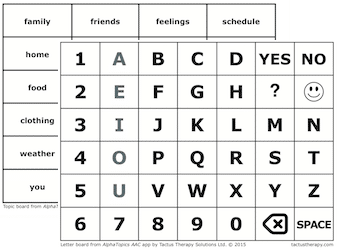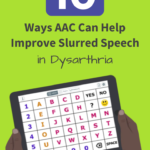10 Ways AAC Can Help Improve Slurred Speech in Dysarthria
8 min read
While some people with communication impairments are non-verbal, producing no speech to communicate, many others have use of their natural speech, but it sounds slurred or unclear. They don’t need a device to communicate for them, but they do need some help. Enter speech supplementation.
Speech supplementation is the “augmentative” part of AAC (augmentative and alternative communication). By pointing to letters or topics on an alphabet board or a topic board, people can make their unclear speech easier to understand. Many scientific studies have been done to examine the effects of using a letter and topic board by people with dysarthria, and the results nearly universally suggest a strong benefit.
Before we start, let me mention AlphaTopics – AAC. This is an app with a design similar to the low-tech boards used in the studies featured here. It adds optional sounds, accessibility settings, visual feedback, convenience, and customization to bring this tried and true method to the modern age.
AlphaTopics AAC
Enhance & clarify natural speech with this simple yet powerful augmentative communication app for dysarthria & aphasia.
Get your FREE printable letter and topic board from AlphaTopics

Without further ado, here are 10 benefits of using letter boards and topic boards to help with speech difficulties:
1) Gives the listener context
By indicating the first letter of the word being said, listeners understand the word better.1 An indistinct “ay” sound made while pointing to “M” tells us the word is “May” instead of “Kay,” “hey,” “bay,” “way,” or “yea.” FYI: Many text abbreviations use just the first letter of each word, and we can often figure out what they mean given the conversational context. WDYT?
AlphaTopics – AAC offers a letter board in alphabetical order with vowels aligned down the side for faster navigation. There are also 2 alternative layouts based on letter frequency to help those who use scanning to be more efficient.
By indicating the topic, the range of possibilities is narrowed.2 When discussing “transportation” as the topic, an unclear “ar” is clearly “car.”
AlphaTopics – AAC offers a topic board with choice of 12 or 24 topics. The topics can be customized, re-arranged, and spoken aloud.
2) Slows down speech
When the speaker must point to the first letter of each word, they naturally speak slower. This rate reduction makes the dysarthric speech easier to understand by marking the word boundaries and giving the listener more time to process the sounds.3 This slowing feature is particularly useful for people with Parkinson’s disease or who otherwise speak very quickly.
3) Improves articulation
Not only does touching each letter slow down the rate of speech, it also improves the actual production of the sounds.4 By taking more time to say each word, the muscles of the mouth may have more time to move to the right position to make clearer sounds.
4) Raises listener’s opinion of the speaker
The better a listener can understand a speaker, the higher their estimation of the person’s abilities.5 When dysarthric speakers use speech supplementation, they are showing that they are trying to help their listeners understand while making themselves easier to understand. Everybody wins!
AlphaTopics – AAC is an app, so it may be socially more acceptable than a laminated paper board. When a listener sees the speaker using a high-tech device, they may also recognize more quickly that the person is intelligent and capable.
5) Faster than typing whole messages
Touching just the first letter while speaking is much faster than typing out whole messages, even with text prediction. Because so much attention is being paid to finding each letter, many people with communication disorders don’t take advantage of predicted text anyway. Typing out each word, correcting typographic errors, and having an app speak the message – pronouncing typos and all – can be frustrating and time-consuming for both the listener and the speaker.
AlphaTopics – AAC has the option of saying each letter aloud. Once the listener thinks they know what the word is, they can say it aloud for the speaker to verify. Even for someone with almost no intelligible speech, spelling in a way that the listener can guess before the word is completed can move the conversation faster than typing whole messages.
6) Helps even when only some words are supplemented
Pointing to the first letter can be done for every word, but it’s also effective for some speakers with dysarthria when done only for key words or when there’s a communication breakdown.6
AlphaTopics – AAC is always there on your smartphone or tablet, so even if it’s not being used all the time, it’s there in a pinch when there’s a communication breakdown. No wi-fi or subscription required.
Likewise, listeners don’t need to see the first letter of every single word to understand better. Just touching it may be enough.7
7) Allows for improved interpersonal connection
When a person uses an app or device to communicate, the listener is often drawn to look at the communication aid to see the message come together. If the speaker prefers to assemble the message without someone looking, the listener often doesn’t know where to look or what to do while waiting.
With an app like AlphaTopics – AAC that shows and/or speaks the first letter or topic, the listener can spend more time engaged directly with the speaker. The interaction doesn’t need to focus on the communication aid – it focuses on the people involved. Eye contact is easier, and there’s no confusion who is talking – the person or the device.
8) Can be used over the phone
Even without seeing or hearing it, telephone conversation partners can reportedly tell whether the speaker is using an alphabet board on the other end.8 This is likely attributable to rate being slower and speech being clearer.
With sounds included in AlphaTopics – AAC, the app can be used to let the person on the other end of the phone hear each of the letters or topics touched.
9) Not (too) complicated
Touching the first letter of each word or starting with the topic isn’t very complicated, but it does take some practice.
Users of speech supplementation need to have basic literacy or sound-letter knowledge (known as phonological awareness). They also need relatively strong cognitive skills to be able to hold the message in mind while pointing to letters and monitoring whether their communication partner is understanding.
However, for speakers with strong literacy and cognition, it’s possible to pick up the technique on the first try. Remembering to use the technique might be the hardest part!
AlphaTopics – AAC has a setting to choose which board, letters or topics, comes up first when the app is opened. For those who have difficulty remembering to indicate the topic first, making the default board the topic board can be a great reminder.
10) Can also be used for aphasia
Establishing the topic, or indicating when the topic changes, is a useful strategy when communicating with a person with aphasia. If the person has difficulty reading, the topics on a topic board can be read aloud to them until they indicate it is correct.
AlphaTopics – AAC has a customizable topic board that will use the text-to-speech voice of the device to read each topic aloud. Use the Emoji keyboard to add relevant symbols to each topic if extra support is needed.
For times when you’re looking for a word on the tip of your tongue, having access to the alphabet can help with the search. A person with aphasia with word finding difficulties, or anomia, can reference the alphabet board to think whether the word they are trying to say begins with each letter.
Who Benefits Most from Speech Supplementation?
Stroke and brain injury9 survivors commonly have dysarthria. The slurred speech strikes suddenly, but can improve over time as the brain heals. Degenerative diseases such as Parkinson’s disease10 and MND/ALS11 (aka amyotrophic lateral sclerosis or Lou Gehrig’s disease) come on more gradually, making speech harder to understand as they progress. Developmental disorders such as cerebral palsy12 also impact speech intelligibility throughout the lifespan.
People with moderate-severe dysarthria tend to benefit more from speech supplementation than those with more mild impairments, but knowing the strategy, practicing the technique, and having ready access to a letter board can help anyone when communication breakdowns occur.
Learn More
There are many systematic reviews, published studies, and chapters in books about speech supplementation in the AAC, dysarthria, and adult communication disorders literature. Here are some excellent sources of information:
ANCDS Practice Guidelines for Dysarthria
Hanson, E. Beukelman, D. Yorkston, K. (2013). Communication support through multimodal supplementation: A scoping review. Augmentative and Alternative Communication, 29, 310– 321
Hanson, E. K. (2014). My Client Talks! Do I Still Need to Consider AAC in my Treatment Planning? Speech Supplementation Strategies: AAC for Clients Who Talk!. SIG 12 Perspectives on Augmentative and Alternative Communication, 23(3), 124-131.
AlphaTopics AAC
Enhance & clarify natural speech with this simple yet powerful augmentative communication app for dysarthria & aphasia.
References
1. Hustad, K. C. Garcia, J. (2005). Aided and unaided speech supplementation strategies: Effect of alphabet cues and iconic hand gestures on dysarthric speech. Journal of Speech, Language, and Hearing Research, 48, 996– 1012.
2. Hustad, K. C Beukelman, D. R. (2001). Effects of linguistic cues and stimulus cohesion on intelligibility of severely dysarthric speech. Journal of Speech Language Pathology, 44, 497– 510.
3 & 4. Hustad, K. C. Lee, J. (2008). Changes in speech production associated with alphabet supplementation. Journal Of Speech, Language, and Hearing Research, 51, 1438– 1450.
5. Hustad, K. C., & Gearhart, K. J. (2004). Listener attitudes toward individuals with cerebral palsy who use speech supplementation strategies. American Journal of Speech-Language Pathology, 13(2), 168-181.
6. Hustad, K. C. Beukelman, D. R. (2000). Integrating AAC strategies with natural speech in adults. In Beukelman, D. R. Yorkston, K. M. Reichle, J. (Eds.), Augmentative and Alternative Communication for Adults with Acquired Neurologic Disorders. Baltimore, MD: Paul H. Brookes.
7. Hanson, E. K. Beukelman, D. R. (2006). Effect of omitted cues on alphabet supplemented speech intelligibility. Journal of Medical Speech-Language Pathology, 14, 185– 196.
8. Michael, K. Kielhold, B. Deelstra, E. Wilson, S. Bettelyoun, H. Hanson, E. K. (2013, November). Alphabet supplementation for telephone communication: Parts I, II, & III. Poster presented at the meeting of the American Speech-Language-Hearing Association, Chicago, IL.
9. Nordness, A. Beukelman, D. Ullman, C. (2010). Impact of alphabet supplementation on speech and pause durations of dysarthric speakers with traumatic brain injury: A research note. Journal of Medical Speech-Language Pathology, 18, 35– 44
10. Tjaden, K. (2008). Speech and swallowing in Parkinson’s disease. Topics in geriatric rehabilitation, 24(2), 115.
11. Hanson, E. K. Yorkston, K. M. Britton, D. (2011). Dysarthria in amyotrophic lateral sclerosis: A systematic review of characteristics, speech treatment, and augmentative and alternative communication options. Journal of Medical Speech-Language Pathology, 19, 12– 30.
12. Hustad, K. C. Auker, J. Natale, N. Carlson, R. (2003). Improving intelligibility of speakers with profound dysarthria and cerebral palsy. Augmentative and Alternative Communication, 19, 187– 198.

